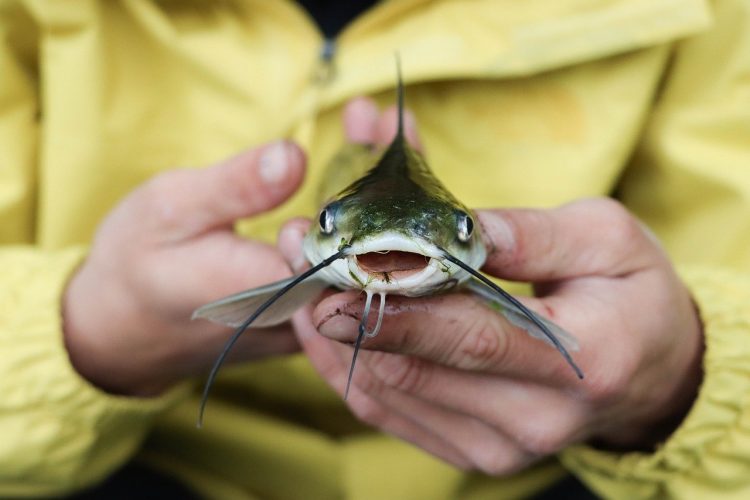Yes, catfish can be poisonous, dangerous, and invasive, but not all of them. There are many species of catfish, and some have proven to be more dangerous than others. Let’s find out more about dangerous catfish in this article.
How Dangerous Are Catfish?
Catfish can be dangerous mainly for one reason. Their sharp dorsal and pectoral spines can cause injury to anyone who is holding them. This is because these spines contain their venom glands. However, this trait is not applicable to all catfish. Usually, there isn’t much danger to a catfish. They are omnivores, and thus everything they need to eat is already there for them in their natural habitat. When you catch them, they will usually be trapped by the hook. But some of them may have those sharp and bony knife-like spines.
If you’re not careful enough, you can become injured after getting stung by them especially if you caught the catfish on a hook. However, any professional or experienced angler will know how to deal with them. Having protection equipment like gloves to save the hands should be enough.

Are Catfish Poisonous?
Yes, they are. When you think of the phrase “poisonous animals,” a fish will definitely not be the first thing on your mind. It would be something like snakes, spiders, and such. Scientists, too, have put a lot of effort into studying the venom of spiders and snakes.
Studies about catfish venom are not widely available. Jeremy Wright, a graduate student from the University of Michigan, was one of the first people to do an extensive study on this. He used histological and toxicological techniques to conduct this study. He also took help from the previous studies of evolutionary relationships among catfish species. From all of these, he managed to prove the presence of venom glands in catfish. He further investigated their biological effects.
You really need to be careful of the poisonous types of catfish. When threatened, some species of catfish can inject a dose of dangerous venom into you. Initially, it was thought that the number of such catfish was very low. But Wright’s study found that more than 1,600 species of catfish may be venomous.
However, you still won’t hear such cases too frequently. This is because catfish mainly use their venom to defend themselves against predatory fishes in their natural habitat. Tt’s a defense mechanism for when they feel threatened by other fish. There are cases where they might use it outside the habitat. The reason why it’s so rare is that there aren’t many instances where the anglers have to come super close to the fish. The hook will trap them after being caught, so they will be too helpless to bite or inject the venom.
How Harmful is Catfish Poison?
As mentioned earlier, the venom glands of catfish are placed alongside their sharp spines on the edge of their dorsal and pectoral fins. When the catfish feels threatened, these spines can be locked into place. When they jab the potential predator with their spine, a wound is created. At that moment, the membrane surrounding the venin gland cells tears down. From there, the venom is released into the wound.
The side effects of this venom are not minor and avoidable. There are three distinct types of toxins in the venom. These toxins can poison nerves and break down the red blood cells. As a result, the victim can suffer from reduced blood flow, body aches, muscle spasms, as well as respiratory diseases. It can also cause dizziness for the victim. You might even suffer from a nasty case of inflammation. However, the initial sting and inflammation isn’t even the most dangerous thing about the catfish venom for humans.
Secondary bacterial and fungal infections sometimes follow the initial effects. The bacteria and fungus can enter through the puncture wound created at the spot or when pieces of the spine and other tissue break off in the wound. In this case, the effects can last up to several months to follow. It’s noteworthy that all the effects listed above will almost never come from a single catfish bite. This is because, according to Wright’s study, all three toxins weren’t present in any of the catfish he examined. The effects are just an overall list of possibilities.
Do Catfish Have an Invasive Nature?
Yes, some catfish are notoriously known for their invasive nature. If they are not controlled from the very beginning, they can take over an entire pond or river within a fairly short time. That’s why anglers are encouraged to aim for catfish that have an invasive nature. The invasive nature of catfish is not exactly their fault or the fault of whoever owns the pond, for that matter. It is just a natural phenomenon that ends up causing trouble for some. Actually, this phenomenon occurs mainly because of their diversified diet.
By nature, catfish are omnivores. So their diet ranges from seaweeds to smaller fish, insects, and other aquatic organisms. They can travel to different parts of the water in search of food, so they have a higher ability to thrive in different places. It can become detrimental to smaller fishes of those regions, but that’s how it goes.
On top of that, their growth rate and their reproductive rate are much faster than the average fish. Hence they both multiply in number and grow in size, and then they spread to different parts of a water body for food and thus become invasive.
Which Catfish Have an Invasive Nature?
However, not all catfish show that big of invasive tendencies. There are mainly two types of catfish: the blue catfish and their cousin, the flathead catfish.
The blue catfish is originally native to the Mississippi, Missouri, and Ohio River basins. Several decades ago, the state introduced the flathead catfish into Virginia waters. The purpose of doing so was to establish a recreational fishery. In fact, the multiplying speed of the blue catfish is so high that it will only take a few weeks or months for the population to reach a level that threatens the normal ecological balance of the river.
Now it’s unimaginable to be anywhere near the James River and not encounter these catfish. They have more or less spread to much of the Chesapeake Bay region. From the studies conducted about the invasive nature of catfish, some solutions have been proposed for people who want to keep the number under control.
Conclusion
Dangerous catfish aren’t something you need to be super scared of. Most anglers know how to identify them. Moreover, if they are found in a particular region, the relevant agencies are notified immediately. So you can just avoid those areas when you go fishing!










Pingback: What Are Saltwater Catfish? | Reel Fishing Guru
Pingback: What Is the Difference Between Catfish and Walleye? | Reel Fishing Guru